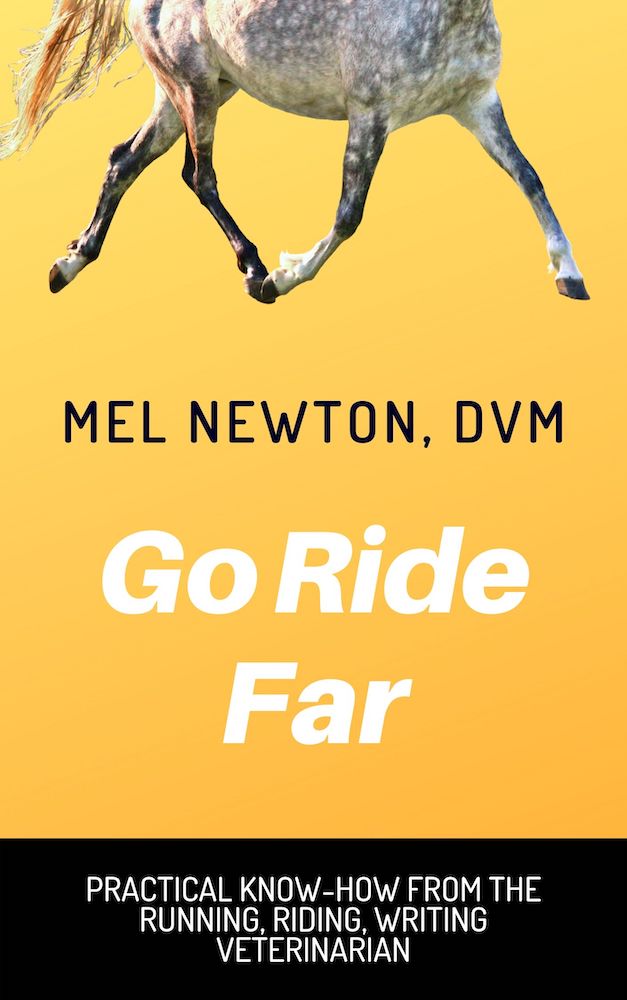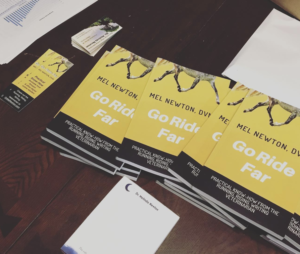Reader question
| May 7, 2013 | Posted by Melinda under Equine Endurance, Most Popular |
Today we have a response to a reader comment that was way too involved to get a response in the comments! Would love to hear whether your advice for this reader is different from mine.
I’ve put her questions in italics and addressed her “sub-questions” one at a time in the non-italicized font…..
First the relevant signalment (that’s what we vet peeps call the age/gender/breed/neuter status. Think of it has a one line history that tells you the relevant history of the animal and gives you a photo in your mind):
Fetti, Haflinger, looking at doing our second LD, first one this year.
AWESOME – So what we have here is a non-traditional breed that already has one LD under her belt (girth?) and is looking for more.
It’s entirely possible we’ll never make it to a 50, but I don’t think it’s unreasonable to aim for some 25s where I don’t have to worry the whole time about time/pulsing down at the end.
AMEN! It’s the number one reason I HATE LD’s. I can remember thinking that neither me nor Farley were going to survive the experience of pulsing down at the finish line on the LD’s that we did. She did NOT understand why we were standing outside of camp away from the trailer, food, water, and the comforts of her Spring Tie. Ugh ugh ugh.
However, keep in mind that you have to pulse into vet checks within a certain time, and you DO have to pulse in to the finish at the 50 mile distances and above in a certain time – it just doesn’t affect your placing. That being said, there is just a diffference (for me at least) of sitting at the finish line trying to get my horse to pulse down, versus pulsing in for a vet check. It’s just different.
And don’t count yourself out for 50’s or even a 100. If you don’t read Funder’s blog – you should. She went from “never going to do endurance” to “maybe I’ll do an LD”, to “a 50 could be OK” to “I can’t WAIT to do a 100!”. And she’s doing it on a Tennessee walker!
With our usual riding partners, average speed tends to be 3-4mph. Am I right in thinking that most 4-10 mile rides with them are not going to do an awful lot for Fetti’s conditioning/fitness level? We’re generally not going above a medium-slow trot, with a fair bit of walking thrown in when the others get tired. Her Big Trot is closer to 7-8mph (on flat ground, but without other horses).
To increase fitness you need to be pushing the horse in either the speed or distance (or difficulty in trail – such as hills etc.) to a level not previously experienced. Maintaining fitness is easier and doesn’t necessarily mean that you are pushing quite as hard. My guess is that by doing the 4-10 mile rides at that speed you are maintaining a certain amount of fitness needed to do an endurance paced LD, but you aren’t actually adding to that fitness in any significant way. I feel that 4-10 miles at 2-4 mph is fine for the majority of your rides, as long as you add 1-2 long rides a month, and an interval workout every 7-10 days.
I would do my long rides at that “big trot” speed, with walk and jog breaks as necessary for 2-3 hours – overall speed will end up being slightly greater than the 2-4 mph, and when you work up to the 3 hour mark, your mileage will be increased as well.
Interval workouts would be done by doing short bouts of that big trot speed up a hill, or on the flats with at a speed slightly faster than the big trot speed, with walk/jog breaks. Perhaps 2-4 minutes doing the fast portion of the interval, followed by 1-2 minutes of slow walk/jog recoveries. The horse should be close to full recovery (ie close to 60 bpm) before doing the next fast interval. So if your horse is struggling to feeling “good” after 1-2 minutes of the slow recovery, you need to back off the speed or duration of your fast intervals.
– Note that by “fast” I don’t mean gallop your horse all out……the fast portion of the interval is just faster than the normal endurance speed – a fast trot or a slow canter.
Those 4-10 mile rides, and finishing that LD last year means that you probably have the base to start doing the long rides and intervals I’ve described above. In fact, for someone that has just started, the slower rides are exactly what I would recommend! However, you are ready to move your conditioning to the next level, to give you a little more of a “comfort cushion” for your next LD.
We did finish the 25 last year at Ride Bear, but just barely pulsed down in time. As a result, I’m currently erring towards the super-fit side of the spectrum.
I would encourage you to step back and think of your conditioning to this point as outside of the seesaw between “super rested” and “superfit”.
This remainder of this post is now available in “Go Ride Far.”
“Go Ride Far” is a collection of revised and updated posts, as well as new content that focuses on what I wish I had known prior to my first endurance ride. (original release details here)
For the price of the fru-fru coffee ($3.99) the ebook covers:
- How to easily and intuitively back a trailer
- Take control of your conditioning and training
- Recognize and fix a “bonk”
- The never before told story of Dr. Mel’s first endurance ride
…and more from the running, riding, writing veterinarian and Singletrack Press!
Paperback versions ($9.99) are available from Amazon, or if you are in the US and want a signed copy directly from me ($10+$2 shipping) contact me at [email protected].
 If you REALLY want a copy of this post and you are McDonald’s coffee broke (seriously, any size for a $1?) and fru-fru coffee is not in the budget, contact me at [email protected] with the title of this post and I’ll send you a pdf copy of the post/chapter. Please consider putting a dollar in my PayPal ([email protected]) or Venmo account, or donating through facebook messenger (facebook.com/drmelnewton) to help cover the cost of this site.
If you REALLY want a copy of this post and you are McDonald’s coffee broke (seriously, any size for a $1?) and fru-fru coffee is not in the budget, contact me at [email protected] with the title of this post and I’ll send you a pdf copy of the post/chapter. Please consider putting a dollar in my PayPal ([email protected]) or Venmo account, or donating through facebook messenger (facebook.com/drmelnewton) to help cover the cost of this site.
Thanks!













Woooo! Yep, no problem with the idea of pulsing down at the end, it just took 20-some minutes last time and that was stressful. I definitely do want to do 50s/longer distances at some point, but I’m not sure it’s in the cards for Confetti.. but I’d happily give it a try if we get to the point it seems doable. Although if we can keep going out by ourselves for conditioning rides and not losing her mind in the process, there may yet be hope!
Long, big-trot rides for 2-3 hours: okay, that sounds doable
Interval workouts: excellent! That makes sense.
What I probably should have said is that for goals, I’m aiming towards the superfit side. I have no illusions that we’re there yet! I’m riding 4-5 days a week, with 4 of those nearly always totalling close to 25-30 miles if I had to guess (for example – we did 7 and then 2 today, 6 Saturday, planned to do 7 on Sunday though we had to abort due to weather, and will hopefully do 6-8 on Thursday). Pony’s in a 12×24 paddock with no dedicated turnout, so super-rested would probably leave me with a crazy fire-breathing dragon.
Read this twice and I’ll probably read it again a few times – thank you, thank you!! This gives us a starting point for a Plan for the next few months, and a basic idea of what may in theory end up working for us. Eagerly awaiting Part Two, and I would promise to quit asking such detailed questions, but I’m sure I’d break that within the next few weeks..
I love reader questions so that’s perfectly fine if you want to keep asking :). Sometimes a question is the catalyst I need to post about a subject that I’ve had in the back of my mind anyways.
regarding the paddock situation with no turnout – that was exactly the situation I was in when I lived in Turlock and was doing my “super fit” phase. So I totoally understand. I hope I did a good job of not making it clear that I don’t think one approach is necessarily better than the other – and I didn’t go out of my way to make my example protocols really crazy to one extreme or the other. Both can work. I personally think that with a non arab you have to error towards the side of super fit (but that post is coming!).
Looking at what you are currently doing – I stand by my post :). You are doing an excellent job of maintaining fitness, but you need to ride harder on some of the days and longer on others. Your total mileage probably won’t change too much on a “normal” week, but you need to distribute your miles and effort differently (ie – ride harder on your hard days and ride easier on your easier days). I say “normal” week, because there will be one week out of the month that should be much higher mileage, followed by a week of much lower mileage, followed by a couple of “normal weeks”. I hope this makes sense :). Got to be careful with the comparison to human running, but in this case, think about what you are doing as tempo runs. You are a marathoner doing tempo runs that will prepare you for 10K-10 mile courses. But what you really need are runs that will prepare you to run double that distance. Sure, some of that is going on a long run or two,but the majority of your running days are NOT long. But you can’t necessariliy fit in the runs you need for the marathon by continuing to run short tempo runs all the time.
Can I enter a reader request for thoughts on pacing one’s first few rides? I see lots of references to “a slow [distance]” and cautions about not going too fast, but not much explanation of what counts as the right kind of slow or as too fast. I get that It All Depends…but would love some general YMMV style advice re: stuff like, how much walking? How much cantering if any*? Rough signs to watch?
*My guy is an event horse, frex, and I’m realizing the extent to which he expects (and prefers) to canter/gallop while out in trails and fields. I have a scheduled blog post for this evening that mentions this a bit — but basically he has a reliable steady relaxed walk and will also go along pretty much indefinitely at a trot with a minute or two of cantering every so often — and physically his back stays happier with some cantering interspersed than he does with pure trot trot trot. So my instinct is to roll with it — but then everything I read is all, YOU WILL TROT FOREVER, and I can see how this is the objectively more efficient gait…so is my instinct wrong, or too strongly calibrated to my primary sport? I don’t think I’m going to break a basically sound horse by cantering a few minutes here and there, but…?
So…….it totally depends (I know, not the answer you wanted). Here’s how I would approach it. If you think that you can do your ride with trot intersperced with short canters, than do it. See how your horse looks at the end, and then decide how to adjust from there. If you think there is a significant chance that you will run into a metabolic or lameness injury by riding the ride like that, than probably not a good choice. If I had been riding my 50’s at walk/trot only and I wanted to see how incorporating the canter in might help (or hurt) me, I would probably chose one distance lower than my current level – ie try out this new strategy on an LD and assess the horse – stronger or more tired than at this point than usual?
My horse is NOT built to canter. Oh sure, especially now that we’ve had tons of dressage she will do it and do it well…..but it’s not a very efficient gait for her. Neither is slow trotting for miles and miles. She does best when allowed to do a faster trot, intersperced with walking. Stashi the ride and tie horse I ride, is super super super efficient at the canter and is BUILT to canter. He would probably lay down and refuse to take one more trot step if he was asked to trot even 10 miles. He feels great and fresh at the end of a fast ride and tie if he has been allowed to canter. When me and my partner did an LD together on our respective horses, She cantered more, I trotted more and we finished at the same time, with great looking horses.
So that’s my bottom line. If you have an inkling of what will work for your horse, and you can try it out in a way that won’t cause you to crash and burn in a 50 or a 100, than do it and reassess. As long as the horse isn’t trying to kill itself by running at the head of the pack, I do feel like they will tell you what they need during the ride in terms of pace.
For me and Farley that means responding to my half halts. At the point that she no longer responds to half halts I have assumed that she is no longer in control of her mental status and now I get to dictate that we go slower. However if she’s moving easily forward and is responding to half halts, she’s not going all “race brain” on me. I will admit that now that I’m going superrested instead of superfit, I’m must more of a dictator with our pace and I’m not likely to let her go at a super fast trot or canter during a ride, even if she’s being good and feels good.
I find that even as a newbie I could trust my gut. If it felt too fast for that day and ride, it probably was. If you even have an inkling as you are going along that you are going too fast, slow up and reassess. If your priority is your horse, and you’ve done your homework, than your gut usually good :). Especially if you are asking the type of questions that you are asking on this blog, and if you don’t have a history of crash and burning at rides on your horses.
Figure: I realized I misinterpreted the first part of your question. Its not that you don’t want to do ld;s because of the.pulsing down, you just want to have more of a cushion when doing them! Sorry about that. The test of the post should be relevant though
Thank you for this — I will be coming back to reread it again tomorrow when I have more brain.
Question: is there any concrete way to know where you are on the seesaw while you are in Real Newb territory? Or is paying attention to the horse and seeing what happens/adjusting to suit and accepting that you’re going to make some mistakes just the way it’s done? (When I write it like that, it seems like a silly question — no mistakes, indeed — I’m not sure why I expect this to be any different than anything else!)
I see you mention different tapers for the longer distances…does the work change as the rides get longer, too, or does one typically keep doing more or less the same thing and build on a series of LD/50/whatever as one works towards, say, a 100? (Not that I expect to ever do a 100, but just out of curiosity!)
So, my experience has been that my at home training remains about the same, but to prepare for a 50 im doing the ocasional ld and to prepare and for the 100 , I’m doing the occasional 50. I think the hardest part of doing a 100 is making the jump from home training to that first ld. After that its easier because you are using the ld and 50s as your long training rides, so you just have to throw.in an interval here and there and and do some light riding. However that is my experience with an Arab. I think training a non Arab to do the same thing can be a bit different, which is what my next post is going to be about.
Oh and thequestion about how to know what part of the see saw you are on? That’s a tough one. 🙂 that is what all of us newbies and nonnewbies obsess over. What part of the seesaw are we on? Every time there is a new horse or a significant change (like me doing from a superfit to a superrested change) its like I have to figure it out again. I have principles I try to go by in the.beginning, and I try to talk to lots people I trust about what they do. Then, I try to figure out how I can keep the same fitness on the.horse with less wear and tear. Some horses keep their fitness with less miles. I actually think that is one of the.differences between an Arab and non Arab, which I’ll discuss tomorrow.
Ha, thank you! At least I’m obsessing over the right stuff.
The shift to super-rested makes a lot of intuitive sense to me for a horse like Farley who has a Really Good historical base of fitness. Do you see it also as a valid approach for a horse starting from scratch?
(I have a strong preference for being overprepared for _everything,_ so my instinct is to err on the side of more fitness than is strictly necessary…but I can see how that would become riskier and riskier as the distances and horse’s historical wear-and-tear builds. And I do like the idea of super-rested from a life balance perspective.)
Thanks again and I will look forward to seeing the next one. 🙂
Either way you have to have a base. I actually think that endurance riders are really really good about setting up a base for their horses. It’s moving out of building base and moving onto the next stage that they seem “stuck” at (myself included). Speed work/intervals have gotten a bad rap in both endurance and running – and us people who are arguably just in this to finish have come to the impression that speed work is only necessary for those people that want to go fast in races. NOT TRUE. Done properly, speed work/interval work will put more fitness on your horse with less miles and is an important point of the triangle (rest, long, speed). So, I think of it like this:
Stage 1: build base. This is neither super fit or super rested. This is base building. This is that long slow miles portion of the conditioning. End of the stage: Horse looks good after going 3-4 hours at 5-7 mph (Completing an LD looking good is good indication you have completed stage 1)
Stage 2: Add interval work. And longer distance work. Again, this stage is still not necessarily on the see saw any where. At this point you are still building fitness to the point where a horse can do a slow 50. Stage 2 doesn’t look any different than stage 1 except now you do the occasional 4-5 hour conditioning ride (in the form of a LD) and ~once a week you do faster work in the form of canter intervals or dedicated hill work.
Stage 3: your horse has the fittness to do a slow 50. Now you get to decide which side of the see saw you want to do. Are you going to continue to build intensity and mileage into your routein (super fit) or are you going to back off and just do the minimum to maintain fitness between rides, and if you are trying to move up distance (to a 100 for example) use rides such as 50’s and a conservative approach during the ride, AND prudent ride scheduling to achieve that goal?
The biggest mistake I see is people staying in stage 1 too long – you can only build up so much – you aren’t doing to do a 50 training ride before your 50. At some point you have ot incorporate other types of riding into your routine (stage 2) The other big mistake is people going directly into stage 3 without spending anytime in stage 2, or going into stage 3 without any concsious decision of which type of stage 3 they want – so they end up in the no man’s middle ground with a horse that is never quite fit enough or rested enough for them to reach their goals.